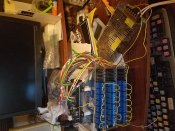I don't know if people would want the extra wiring and expense? Getting all pixel board manufacturers to implement it could also be tricky.
The daisy chaining is also a not an insignificant issue. What happens with custom made props? They would need an extra module programmed to suit and that would have to be done by the end user.
The overall idea is nice in general, but i don't see it as being viable. Happy to be proven wrong of course.
The daisy chaining is also a not an insignificant issue. What happens with custom made props? They would need an extra module programmed to suit and that would have to be done by the end user.
The overall idea is nice in general, but i don't see it as being viable. Happy to be proven wrong of course.



